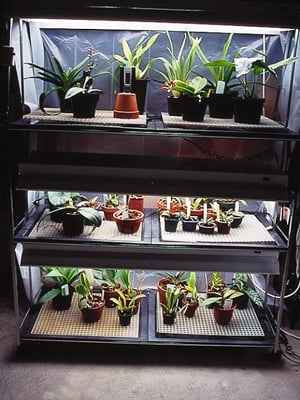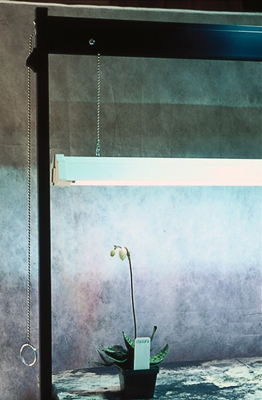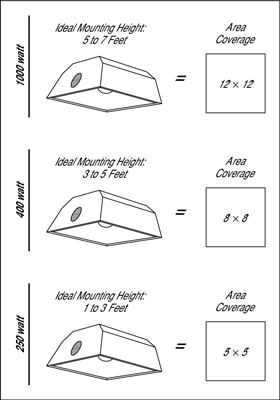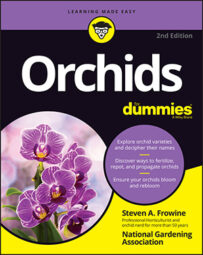Artificial light sources make it possible you to grow orchids without greenhouses or bright windowsills. You can grow any kind of orchid in artificial light. The cost of equipment and electricity are your only limitations.
Fluorescent lights
Fluorescent systems are the most accessible and economical lighting systems to buy. Three-tiered light carts are highly versatile and practical. Most of them are about 2 feet wide by 4 feet long, so their three shelves provide 24 square feet of growing area. If you grow compact orchids, this will be enough space to have at least one or more orchids in bloom year-round. If you collect miniatures, it will provide a growing space adequate for an entire collection. The convenience of such a cart can't be beat. You can place it in a heated garage, in a basement, or in a spare bedroom.

When the orchids start to produce their tall orchid spikes, there usually isn't enough head room under most fixed-height light units to accommodate this growing spike. At that point, you can move the orchids to a windowsill or use a light fixture that can be raised as the flower spikes develop.

Which bulbs or lamps you should burn in your fixtures is a highly debated topic. Years ago, the only real choice was cool white and warm white tubes. Some people still feel that a 50/50 mix of these tubes is the best option, because they're bright and very inexpensive.
Over 40 years ago, Sylvania started manufacturing Gro-Lux tubes — designed to provide light that more closely reflected the spectrum of light that plants used in photosynthesis, the process that plants use to produce their own food. This started a new race to produce the "best" plant bulb. The evolution of lamps has gone from the Gro-Lux to wide-spectrum bulbs and now to full-spectrum bulbs. The light cast by the full-spectrum lamp is supposed to most closely resemble natural sunlight. Viewed under these lamps, colors of the flowers are rendered more accurately.
High-intensity-discharge lights
Newer to the artificial-light choices are high-intensity-discharge lights. These are very efficient in their production of light and are especially useful where you want to grow orchids requiring higher light intensities than fluorescent lamps can provide and/or where you want a greater working distance between the lights and plants.

High-intensity-discharge lights do have the disadvantage of producing quite a bit of heat, so make sure not to get the plants too close to the bulbs.
The two most frequently used lamps for these systems are metal halide (MH) and high-pressure sodium (HPS). HPS is more energy-efficient than MH, but the light it emits is orange-yellow and distorts the color of the flowers and foliage. MH produces blue light that is more pleasing to the eye. Some manufacturers now produce lamps that combine the advantages of both.
Another newer option is the high-intensity compact fluorescent light. The fixtures for these look much like high-intensity-discharge (HID) units. They don't produce quite as much light as HID, but they have the advantage of producing little heat — so there is much less likelihood of orchids being burned.

